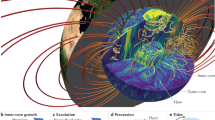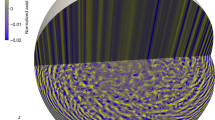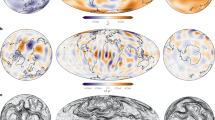Abstract
Higgins and Kennedy1 have suggested that the Earth's core is in stable equilibrium. If this is so there cannot be the large scale steady motions with a radial component which have usually been thought necessary for the dynamo theory of the Earth's magnetic field. A stable fluid can have internal wave motions and it seems worth considering whether a body of fluid can act as a dynamo and produce steady electric currents and magnetic fields even when the motion is purely oscillatory. The work of Moffat2,3, Roberts4 and Steenbeck and Krause5 shows that this is so in an infinite fluid and it seems likely that it will be true in a sphere. The discussions of fluid dynamos are necessarily complex and we have therefore considered the very simple case of an oscillatory disk dynamo. This dynamo consists of a disk oscillating about its axis of symmetry with a coil connected to brushes on the axle and at the edge of the disk. Any current in the coil will produce a field, the motion of the disk in the field produces a current in the coil and maintains the field. The equation for the current, I, in such a system is easily shown to be6 where L and R are the inductance and resistance of the circuit, 2πM is the mutual inductance of the coil and the disk and Ω is the angular velocity of the disk. The equation bears an analogy to Maxwell's equations for the field, B, in a fluid of conductivity σ and permeability μ moving with velocity v, which give
where L and R are the inductance and resistance of the circuit, 2πM is the mutual inductance of the coil and the disk and Ω is the angular velocity of the disk. The equation bears an analogy to Maxwell's equations for the field, B, in a fluid of conductivity σ and permeability μ moving with velocity v, which give  In both cases the question is, can the interaction of the motion and the field, the term on the right, balance the second term on the left to give an average İ or Ḃ which is zero or positive ? If the motion is oscillatory the answer will depend critically on the relative phase of the motion and the current or field, that is of Ω relative to I in equation (1) or v relative to B in equation (2) (the mean of cos t sin t is zero, but the mean of cos2t is ½). The study of equation (2) needs elaborate mathematical techniques, since B is a function of space as well as time. For equation (1), however, there exists an elementary solution; it shows that the phase relations are wrong and that the current is not maintained. It is known, for steady motion, that two coupled disk dynamos with the current from each feeding the coil of the other possess properties not shown by the single dynamo7,8. We have studied such a system with oscillating disks and have shown that a current with a steady part may be maintained or caused to grow exponentially so long as some Fourier component of the oscillations of one disk is out of phase with the corresponding component of the motion of the other.
In both cases the question is, can the interaction of the motion and the field, the term on the right, balance the second term on the left to give an average İ or Ḃ which is zero or positive ? If the motion is oscillatory the answer will depend critically on the relative phase of the motion and the current or field, that is of Ω relative to I in equation (1) or v relative to B in equation (2) (the mean of cos t sin t is zero, but the mean of cos2t is ½). The study of equation (2) needs elaborate mathematical techniques, since B is a function of space as well as time. For equation (1), however, there exists an elementary solution; it shows that the phase relations are wrong and that the current is not maintained. It is known, for steady motion, that two coupled disk dynamos with the current from each feeding the coil of the other possess properties not shown by the single dynamo7,8. We have studied such a system with oscillating disks and have shown that a current with a steady part may be maintained or caused to grow exponentially so long as some Fourier component of the oscillations of one disk is out of phase with the corresponding component of the motion of the other.
This is a preview of subscription content, access via your institution
Access options
Subscribe to this journal
Receive 51 print issues and online access
$199.00 per year
only $3.90 per issue
Buy this article
- Purchase on Springer Link
- Instant access to full article PDF
Prices may be subject to local taxes which are calculated during checkout
Similar content being viewed by others
References
Higgins, G., and Kennedy, G. C., J. Geophys. Res., 76, 1870 (1971).
Moffatt, H. K., J. Fluid Mech., 41, 435 (1970).
Moffatt, H. K., J. Fluid Mech., 44, 705 (1970).
Roberts, G. O., Phil. Trans. R. Soc., 266, 535 (1970).
Steenbeck, M., and Krause, F., Z. Naturf., 21 a, 1285 (1966).
Bullard, E. C., Proc. Camb. Phil. Soc., 51, 744 (1955).
Rikitaki, T., Proc. Camb. Phil. Soc., 54, 89 (1958).
Allan, D. W., Proc. Camb. Phil. Soc., 58, 671 (1962).
Bullard, E., and Gubbins, D. (in the press).
Author information
Authors and Affiliations
Rights and permissions
About this article
Cite this article
BULLARD, E., GUBBINS, D. Geomagnetic Dynamos in a Stable Core. Nature 232, 548–549 (1971). https://doi.org/10.1038/232548b0
Received:
Issue Date:
DOI: https://doi.org/10.1038/232548b0
This article is cited by
-
On the magnetism of stars and planets
Astrophysics and Space Science (1997)
-
The Earth's deep interior
Die Naturwissenschaften (1976)
-
Thermal regime of the Earth's interior
Nature (1975)
-
Convection in the Earth's core
Il Nuovo Cimento B Series 11 (1975)
-
The melting relations of iron and temperatures in the earth’s core
La Rivista Del Nuovo Cimento Series 2 (1975)
Comments
By submitting a comment you agree to abide by our Terms and Community Guidelines. If you find something abusive or that does not comply with our terms or guidelines please flag it as inappropriate.



